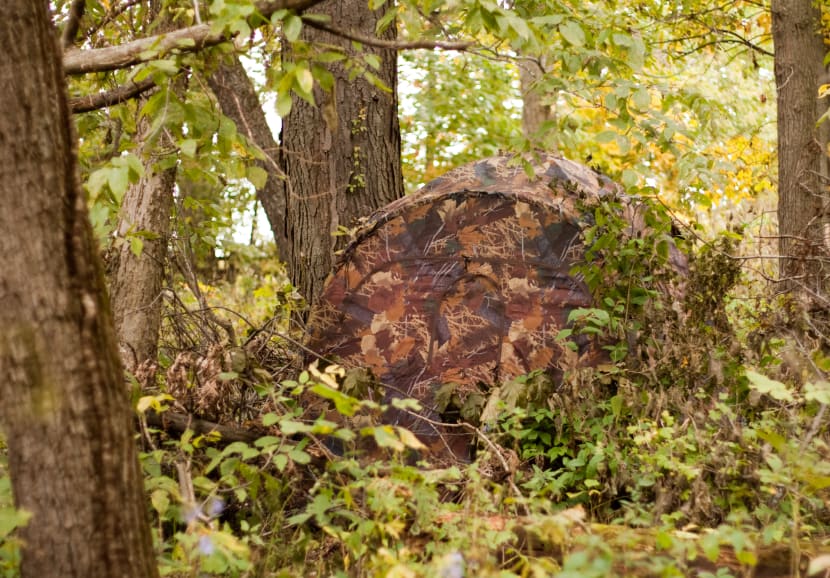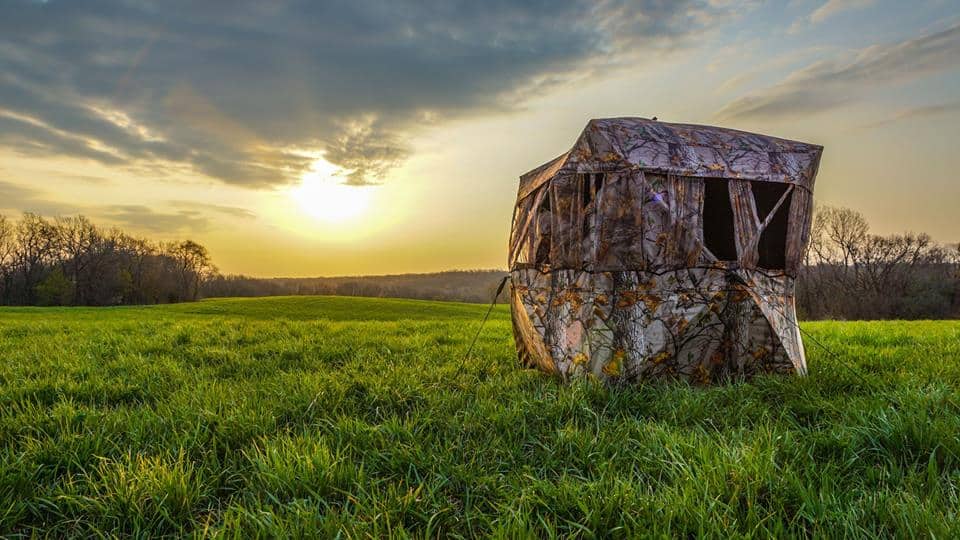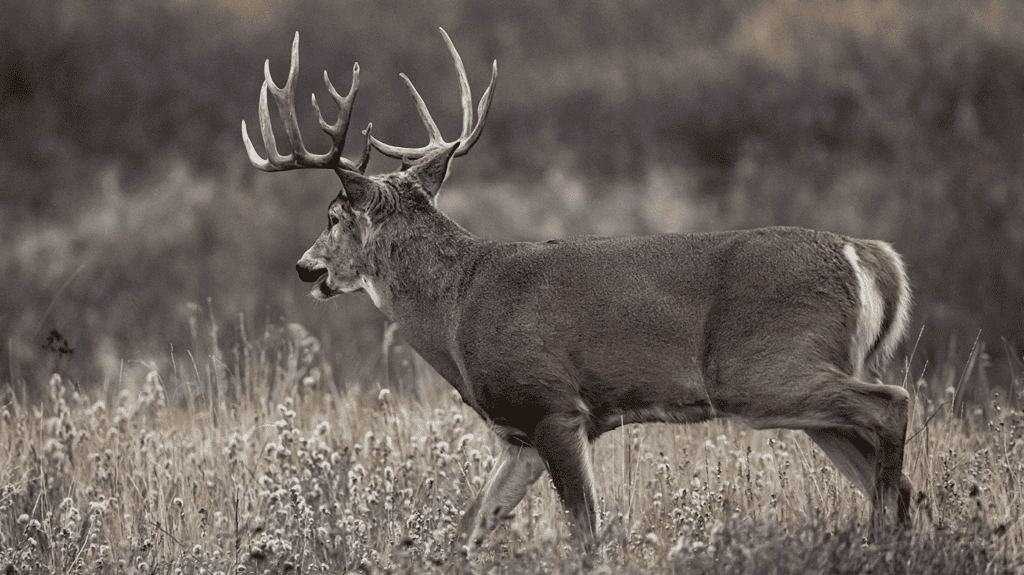Hunting from the elevated position and concealment of a treestand is often preferred by most hunters, but there are significant advantages to knowing when and how to employ the use of a ground blind in the right situations. If you truly want to maximize your potential for success in bagging a buck, listen up because today, I’m talking about the pivotal advantages you’ll get with hunting from a ground blind.
The many benefits you’ll get from hunting in a treestand are obvious to veteran hunters and even rookies who have learned the hard way that elevation is sometimes key when it comes to camouflage and scent management. It’s clear that you can greatly expand your field of view from a treestand–especially if you place your stand in an ideal location.
Scent management is another area of superiority for tree stands over ground blinds. When you get high enough, your scent can blow over an area instead of through it. However, ground blinds can help with scent control, and I have an entire article about it that you can read here.
With things like this in mind, it’s easy to be lulled into thinking that using a treestand throughout the whole season is the best course of action, but using a ground blind is not just for small children and elderly hunters. Here are some points to keep in mind to know when to use a ground blind to get a huge advantage this deer season.

Moving Your Position Quickly and Easily
If you’re hunting an area that you haven’t been able to properly scout, you might be better off opting for a ground blind instead of a treestand. This is often the case when hunting public land. They may hunt in the morning and notice deer using a certain trail or the wind has shifted significantly in another direction, or they just aren’t happy with their chosen location and want to relocate.
Moving a treestand–even a climbing stand–can disrupt the usual peace and quiet enough to spook mature bucks out of the area. Yet having a quality ground blind that is capable of being set up and taken down quickly and quietly offers hunters the ability to relocate with less noise, and less hassle in most cases.
The Element of Surprise
It’s becoming more and more evident to professional and veteran hunters that most mature whitetail deer eventually learn to start checking their surroundings horizontally and vertically. It’s not uncommon to see big bucks in heavily-pressured areas scanning the forest floor, as well as some of the trees around them while they go about their business. By using a ground blind that’s adequately concealed and well-placed, you can give yourself the chance of fooling a big buck that might be expecting death from above.
If you’ve hunted an area and have been spotted by a particular buck once or more, it might be a good idea to change up your approach and sneak in under their radar by hunting from the ground. Remember that large bucks are extremely intelligent and will sometimes instantly notice something that looks out-of-place in their usual habitat, like an exposed ground blind.
This is why it’s important to make sure your ground blind blends in as much as possible with your surroundings and that it isn’t in a place where it’s going to stick out like a sore thumb.
If you want a little more guidance on how to make your blind as concealed as possible, check out this article I wrote titled “How NOT To Spook Deer With Your Ground Blind.”
Total Concealment and Camouflage
There are times when you’re better off ditching your treestand in favor of a ground blind to achieve a higher level of concealment. You may be hunting over a specific deer trail, scrape line or some other focus point and it can pay dividends to set up your position well ahead of time. Having a solid ground blind setup allows you to do things like grunt and use rattling antlers without having all of your movement exposed.
Calling or rattling from the trees will work on occasion, but if a buck is close enough, he will be able to discern whether or not the sound is coming from the ground or a tree. Since most bucks are well-aware that their fellow whitetails don’t usually call or fight in a tree, they will almost always go the other way if you make the mistake of calling or rattling when they are too close.
Using a ground blind is perfect for maximizing your potential with rattling antlers and grunt or bleat calls as the sound waves will be coming from the ground as expected. You can even scratch around on the ground when rattling to make it sound more realistic. Just be ready to drop the calling tools or binoculars and pick up your bow or rifle in time to position yourself for a good shot once they begin to close in.
Did You Know I Had a Newsletter?! 📬
I do! I send out a weekly email that talks all about deer hunting and is a bit more personal than a regular article. If you sign up right now, I will even send you the first chapter of my Ebook “The Hunters Guide to Scent Control” for free! What is there to lose? 🙂
Adapting to Foliage and Terrain
The most common reason why so many deer hunters opt for a ground blind over a treestand is because of the foliage and terrain they are hunting. Using a treestand is ideal for hunting when the elevation provides an optimal viewpoint down into trails and other areas where you can expect to see your quarry. There are some occasions, however, when hunting from the ground provides a longer and clearer sight picture.
During early autumn, the foliage on trees can be fairly thick, making it difficult to see a great distance from a treestand. A ground blind often allows hunters to have a much farther view into the distance, depending on the amount of brush and saplings covering the forest floor. You can also use a ground blind to get a huge advantage by placing it in the right terrain overlooking a saddle, shelf or other type of land structure where deer are known to traverse.
A hill overlooking a food source or heavily-used trail is often prime real estate for ground blind hunters throughout the season. While it’s still just as important to keep the wind direction in mind when using such locations, you’ll also need to factor in the angle of the sun as it rises and sets.

Hunters can gain the upper hand by making sure the sun is always at their back instead of shining directly towards them. If you make the mistake of setting up in a spot where you’re looking into the rising or setting sun, this will basically illuminate your face, body and any equipment you have–making it very easy for a deer to spot you before you can get a shot.
If the sun is at your back, you’ll blend in as just another silhouette along the forest floor and you’ll be in an optimal position for those magical early morning or late evening moments when trophy bucks venture out into the open.
Wearing the right kind of gear in a ground blind will help too. You don’t necessarily have to wear your best camo when the ground blind is concealing you. If you want to know more about the best gear to wear in a ground blind, read my article titled “What Should You Wear While Hunting in a Ground Blind.”
Safer Alternative Than Climbing a Tree
Another major advantage that some hunters rarely consider with ground blinds is safety. Climbing a ladder or even using a climbing stand can be extremely dangerous when conditions are icy or wet and many hunters have suffered terrible injuries falling out of treestands in such situations.
It’s always a good idea to have one or two ground blind locations set up on your hunting property in case of treacherous conditions. Slipping into a ground blind is much safer than attempting to climb into a treestand before dawn. Ground blinds also offer a safer alternative in terms of shot angle as well, in most cases.
Extra Tips
What I have covered thus far are the main benefits of using a ground blind, but there are a few more little things that I just can’t not cover! Let’s get into them.
Extra Camo is Key
Mature bucks are going to be much more keen on catching the slightest movement in the woods, so having a ground blind that offers maximum camouflage will be more optimal. Concealing your movement, no matter how controlled it is, is a huge benefit to ground blinds, and if you are a fidgety person, a ground blind could keep you from spooking deer.
Instead of just relying on the fabric or camo-pattern of your ground blind, it’s always best to customize your blind by placing some naturally-occurring growth in and around it. This can be as simple as cutting a few limbs off of nearby brush and trees and interweaving them into your ground blind’s exterior, or you can go the extra mile and add a longer-lasting amount of leaves and other items.
Some hunters will purchase fake leaves and vines and glue them to the exterior of their ground blind to create a much more natural appearance. Keep in mind that cutting down any brush or limbs during the early season will mean that you will probably have to replace these dead limbs later in the season once the leaves begin to change color and fall.

Mix It Up
It’s usually best to hunt from a ground blind on an occasional basis, mixing this approach with the use of a treestand. If you hunt too often from a ground blind, especially one that has remained in a single location for weeks or months, the deer on your property will often begin to expect your presence and this strategy will lose its effectiveness.
Go the Extra Mile on Scent Containment
One of the major downsides to hunting from the ground is the fact that your scent will be more prevalent in the area where deer are going to be walking through. You can often get by with minimal scent control efforts when using a treestand because your scent can be carried off with the wind, away from your position. However, this is not the case when using a ground blind.
You’ll need to ‘go the extra mile’ when it comes to containing your scent when hunting from a ground blind if it’s possible. This means showering before your hunt, washing your clothes and using scent blocking gear and clothing, as well as scent cover spray and other strategies. There are a number of different methods hunters use to contain their scent from the ground, but it’s often best to be as cautious as possible and keep yourself and your gear scent-free.
I have written an entire book about scent control and how to customize a scent control routine to your way of hunting. Check it out here.
Proper Setup is Crucial
Hunting from a ground blind means gaining a few advantages and also losing some at the same time. If you pay attention to your surroundings and set up your blind the right way, you can avoid some of the common pitfalls that turn most hunters off from using ground blinds as part of their overall season’s hunting strategy.
Having your blind in the right location is very important and making sure it blends in with its surroundings is a must. It’s also essential to think ahead and eliminate any potential problems that could spook deer away from you. Choose a spot where you can see down more than just one shooting lane.
Make sure to clear away any limbs or brush that could catch hold of you or your gun or bow while you’re positioning yourself for a clean shot, too. It’s also a great idea to remove or rake away as many leaves as you can from the floor inside or under your blind, that way moving your feet around won’t make a single sound.
Getting The Most Out of Your Ground Blind
While hunting from an elevated tree stand has its obvious advantages, knowing when and how to use a ground blind can provide hunters with a huge advantage in certain situations. Ground blinds offer unique benefits, such as easy mobility, surprising mature bucks, total concealment and camouflage, adaptability to foliage and terrain, and a safer alternative to climbing a tree.
When hunting in areas where scouting time is limited, or when trying to outsmart mature deer, ground blinds prove to be effective tools. Ground blinds also allow hunters to use calls and rattling antlers more effectively, providing a more realistic and enticing experience for deer.
To maximize the advantages of ground blinds, extra camouflage, proper scent containment, and thoughtful setup are essential. By incorporating ground blinds into their hunting strategy alongside treestands, hunters can increase their chances of success and achieve a well-rounded and versatile approach to deer hunting. Remember, understanding the specific circumstances and terrain is crucial to making the most of the significant benefits that ground blinds can provide during the deer season. Good luck in your ground blind this year!
Sister Post | Do Ground Blinds Help Scent Control?
A sister post is another post that I have written that follows along with the same topic as the one you just read. After reading this article, you will probably like this next one even more! Here is a little teaser…
Poor scent control has spooked millions of deer, and there’s a good chance you are responsible for a couple dozen of those. We have all spooked plenty of deer, but staying as stealthy as possible is the goal. Ground blinds are a great tool for that…Keep Reading
Start With the Blind Itself
If a ground blind is going to help you with scent control, it can not have a human odor. If you just got a shiny new ground blind from a big box store, or if you have been keeping it in your garage all off-season, it has a human odor…Keep Reading
You Can Avoid Some Wind, but Not Much Else
So how much does a ground blind help? All they really are are thin sheets of polyester, so don’t depend on them too much. Plus…Keep Reading
Thank you for reading my article! I hope you enjoyed it, and if you have any questions or feedback, please send me an email at Patrick.Long@omegaoutdoors.net. If you want to learn more about me or Omega Outdoors, visit my About Page. Otherwise, I hope you have a great day, and check out some of my other articles while you’re here!
